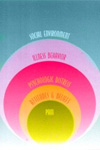|
The average clinical hospital, ambulance or praxis worldwide has to deal mainly with acute disturbances. According to this fact, the mechanistic approach that sees a clear, provable and mechanical damage behind every pain is spread most common around the world. If someone repairs this damage, the cause solves up and everyone is happy again. This might be true in a lot of acute conditions.
But in the last decades, science could show that chronic pain can progress rather shortly into a chronic pain disease that can be totally independent from "new" pain inputs. Furthermore such a chronic pain can cause deep suffering and massive influence on our wellbeing, our mood, can make us aggressive or helpless and can lead to strong social cocooning with increased isolation in job, family and partnership.
These findings led to the conclusion that we should use a new, a broader pain model that unifies physical, psychological and social aspects - the biopsychosocial disease model was born! The international pain community established exact algorithms, how to approach the very complex chronic pain disease.
Per definition we call it chronic pain, if the pain has been lasting for more than 3 months with an intensity of >5 on a visual analogue scale (VAS) from 0=no pain and 10=worst imaginable pain.
The first step is, to exclude a "bad" cause of the pain - the so-called "red flags" of back pain like e.g. fracture, inflammation, carcinoma, disc prolapse... We can find such a red flag in less than 4% of painful back conditions. That means that in >95% of painful disorders we can't find any major structural damage. That doesn't mean that it cannot hurt - but: THE INTENSITY OF PAIN AND THE SEVERITY OF THE CAUSE HAS A VERY BAD CORRELATION! The structures with the highest concentration of pain receptors are neither the discs (we just have very few receptors on the back side) nor the bones. The nerve root is also rather rare causing a backpain. It is the soft tissue with ligaments, joint capsules, tendons, fasciae,.. that is innervated most with pain receptors. The good information is - MOST OF THE CHRONIC PAINFUL DISORDERS ARE NOT CAUSED BY STRUCTURAL DAMAGE BUT BY FUNCTIONAL DISTURBANCES! If you suffer from chronic spinal pain it is mostly not possible to heal you from this pain, because you will have a genetical predisposition to get back pain. But an achievable goal for more than 90% of chronic spinal pain patients is to reduce the number, duration and intensity of pain episodes per year markedly.
How can this be reached: after a professional combination therapy by Dr. Stengg to stabilize the pain on a lower level, we train your superficial and deep spinal stabilizing muscles with a high-tech-approach of training therapy in an intensive care setting. The youngest successful patient was 11 years old, the oldest one 91 years.
What is the therapeutic goal on the physical level? The strength performance regarding maximum voluntary contraction and strength endurance will be improved as well as the body awareness and coordination abilities. Furthermore the heart-lung-endurance will be trained, shortened muscles will be stretched and reduced mobility will be normalized again as far as possible.
|

 |

